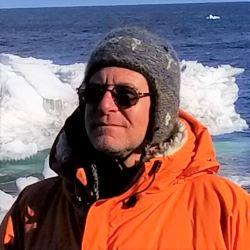Christopher Jones, Ph.D.
Christopher Jones is a Research Fishery Biologist and leads the Finfish and Benthic Invertebrate Program for the Antarctic Ecosystem Research Division (AERD). He joined NOAA Fisheries in 1991, and has been with the AERD since 1998. He earned his Ph.D. in Marine Biology and Fisheries at the University of Miami in 2003. His research involves population characterization, dynamics, and assessment of Antarctic finfish, and their relationship to other components of the Antarctic ecosystem, management approaches, and policy initiatives. His benthic invertebrate work has primarily revolved around detecting and minimizing risk of disturbance to Vulnerable Marine Ecosystems in the Southern Ocean. He has participated in numerous collaborative studies involving demersal finfish surveys of Antarctic toothfish and other finfish species. He also serves as U.S. technical coordinator for the CCAMLR scientific observer program. His research is primarily used to provide scientific advice for U.S. policy on fisheries and other management issues in the Southern Ocean.
Selected Publications:
Parker, E., Jones, C.D., Arana, P.M. et al. 2020. Infestation dynamics between parasitic Antarctic fish leeches (Piscicolidae) and their crocodile icefish hosts (Channichthyidae). Polar Biology. 43, 665–677. DOI:10.1007/s00300-020-02670-x.
Arana, P.M., Jones, C.D., Alegría, N.A., Sarralde, R., and R. Rolleri. 2020. Antarctic demersal finfish around the Elephant and the South Orkney islands: distribution, abundance and biological characteristics. Latin American Journal of Aquatic Research. 48(2):304-322. DOI: https://doi.org/10.3856/vol48-issue2-fulltext-2469.
Jones. C.D. 2018. Reflections from a Previous Chair of the Commission for the Conservation of Antarctic Marine Living Resources Scientific Committee. Antarctic Affairs. V:75-81.
Near, TJ., MacGuigan, D.J., Parker, E., Struthers, Jones, C.D., and A. Dornburg. 2018. Phylogenetic analysis of Antarctic notothenioids illuminates the utility of RADseq for resolving Cenozoic adaptive radiations. Molecular Phylogenetics and Evolution. 129: 268–279. DOI: 10.1016/j.ympev.2018.09.001.
Dornburg, Alex., Federman, S., Lamb, A.D., Jones, C.D., and T.J. Near. 2017. Cradles and museums of Antarctic teleost biodiversity. Nature Ecology & Evolution. 1, 1379–1384. DOI:https://doi.org/10.1038/s41559-017-0239-y.
Xavier, JC., Brandt, A., Ropert-Coudert, Y., Gutt, J., Jones, C.D., Lochte, K., Peck, L., Kennicutt C. and W.J. Sutherland. 2016. Future challenges in Southern Ocean life and ecology research. Frontiers in Marine Science. 3:94. DOI: https://doi.org/10.3389/fmars.2016.00094.
Jones, C.D., and T.J. Near. 2012. The reproductive behaviour of Pogonophryne scotti Regan confirms that egg-guarding parental care is widespread among the major evolutionary lineages of Antarctic notothenioids. Journal of Fish Biology. 80(7): 2629–2635. DOI: https://doi.org/10.1111/j.1095-8649.2012.03282.x.
Near, T.J., A. Dornburg, K.L. Kuhn, J.T. Eastman, J.N. Pennington, T. Patarnello, L. Zane, D.A. Fernández, and Jones, C.D. 2012. Ancient climate change, antifreeze, and the evolutionary diversification of Antarctic fishes. Proceedings of the National Academy of Sciences. 109(9):3434-3439. DOI: https://www.pnas.org/content/109/9/3434.
